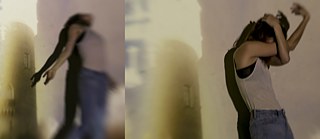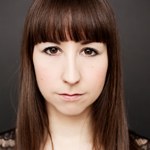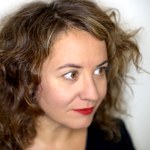Dance residency in Potsdam, Germany
NODE by Amélie and Nelly-Ève Rajotte

The choreographer and contemporary dancer Amélie Rajotte and the video and sound artist Nelly-Ève Rajotte are the most recent artists in residence of the Studio Québec programme at fabrik Potsdam, Germany. As part of this annual exchange, Canadian and German choreographers and artists from related fields are invited to work in the other country for several weeks.
By Philip Szporer
During their stay in Potsdam, the Rajotte sisters embarked on a new project called “NODE”, a conceptualisation that integrates their respective artistic mediums, dance and digital art.
Philip Szporer talked with Amélie and Nelly-Ève Rajotte after their return to Montreal.
Amélie and Nelly-Ève Rajotte, why was this residency in Potsdam important for you?

Nelly-Ève :The residency allowed me to take a step back from my artistic creation and give it new breath, and it also allowed me to work with a choreographer. Leaving my creative context behind was essential for the project since we wanted to work with the loss of physical and spatial references.
Amélie, did the location Potsdam play an important role in the development of the project?
Amélie : Yes, Potsdam and other places. Before leaving we knew which themes and mediums we wanted to tackle but the rest evolved on site based on encounters and discussions we had, and from the places we visited.
Most of the video footage that Nelly-Ève used for this project was filmed in Potsdam and on the island of Rügen in the north of Germany during our numerous trips. In search of inspiration we also visited museums and biked around Potsdam. We were inspired by the castles, the light and the colours as well as the German romanticism, among others by Caspar David Friedrich’s paintings. The painter places the human body in the vast, sublime landscape. The sublime became our driving force for exploring the loss of reference points. This was even more befitting since the art of Nelly-Ève has been evolving around landscape, and I have been interested in working with emotions and the conditions of the body. And, finally, fabrik Potsdam also played a role because it allowed us to concentrate fully on research and the creative process.
Amélie and Nelly-Ève, how did the idea of collaboration evolve for each of you?

For this purpose we created long periods of improvisations that integrate dance, music and video. Initially we also wanted to integrate mapping (a technique where images are projected two- or three-dimensionally onto objects) based on geometric shapes but our research quickly revealed that round shapes are more suitable to give the work a certain femininity and a dreamlike aspect.
As a result, our research moved towards monumental inflatable shapes that were difficult to find on site in a short period of time. So we worked with two gigantic balloons that allowed us to do tests “to scale”. That way we could work with volumes, relief and perspectives and see how light and images can adapt to shapes.
Amélie, tell me about your “body archives” ideas.
Amélie : I am fascinated by everything that forms our body, the ability of the human body to absorb, archive and appropriate information. When I start new research, the first thing I do is an inventory of images (paintings, photos, film excerpts), meaning positions, actions, gestures that I have seen, lived, accumulated, that I love and I am obsessed with. This is the basic material of my work. I research how I will make these images, shapes and attitudes emerge, then deconstruct them and take them out of their context, in other words which qualities and which body conditions can be used to transmit these bodily archives and give them a new meaning. This is a method to free them of their meaning and unveil the importance of behavioural processes. I love moving around points of reference and significant frameworks.
Nelly-Ève, can you elaborate on your research in the field of physical sensations and psychological conditions converging towards responsiveness.
Nelly-Ève : In my art, I have always pursued sensorial destabilisation based on the principle of psycho-acoustics and visual distortion. The idea behind it is to trigger in the viewer, especially in this project, a loss of the sensorial reference points. So I developed the sound composition based on long audio loops that accumulate and then quietly disappear. The video image was set up in a similar way and certain pulsating effects in the image were generated in real time based on different sound frequencies. The low frequencies relate directly to the sensations of the body when it interacts with more destabilising high frequencies. The composition was created as a dramatic escalation until the moment when the image breaks apart. That way there is an escalation of the reverential landscape image until its near abstraction. The loss of reference points is established on two levels, the dancer and the viewer.
And, lastly, how do you come out of your stay in Germany? Did it alter, enrich or change you? How, looking back, do your describe your experiences?
Amélie :Altered, enriched, yes, it has also allowed me to reconnect with my inner self and take stock of my journey. What have I accomplished as an artist, what do I want to do next? To have time to do this is a great chance. I also learned a lot by encountering my sister in the workspace. It was stimulating to gain a new perspective of body and space. We also had the opportunity to meet highly inspiring artists and to perform with some of them. By the way, I hope that my journey as an artist and this new creative project will lead us back to Germany. In the meantime the stay in Potsdam certainly allowed us to lay the foundation for this work in the making, and move it along far enough to start the next creative phase and produce it in Montreal.
Nelly-Ève : This experience enriched me personally in my art. I also believe that my art was at a point where I needed to be in a different creative context, I needed to leave my daily routine behind and concentrate fully on the creative process and learn to work with the body in a total work of art. Connecting my artistic creation with that of another artist was highly stimulating. The German painters of the Romantic era were also a strong inspiration and reassured me as an artist. The residency allowed me to experience encounters relevant for an artistic research that will be nourished by new creative pathways.